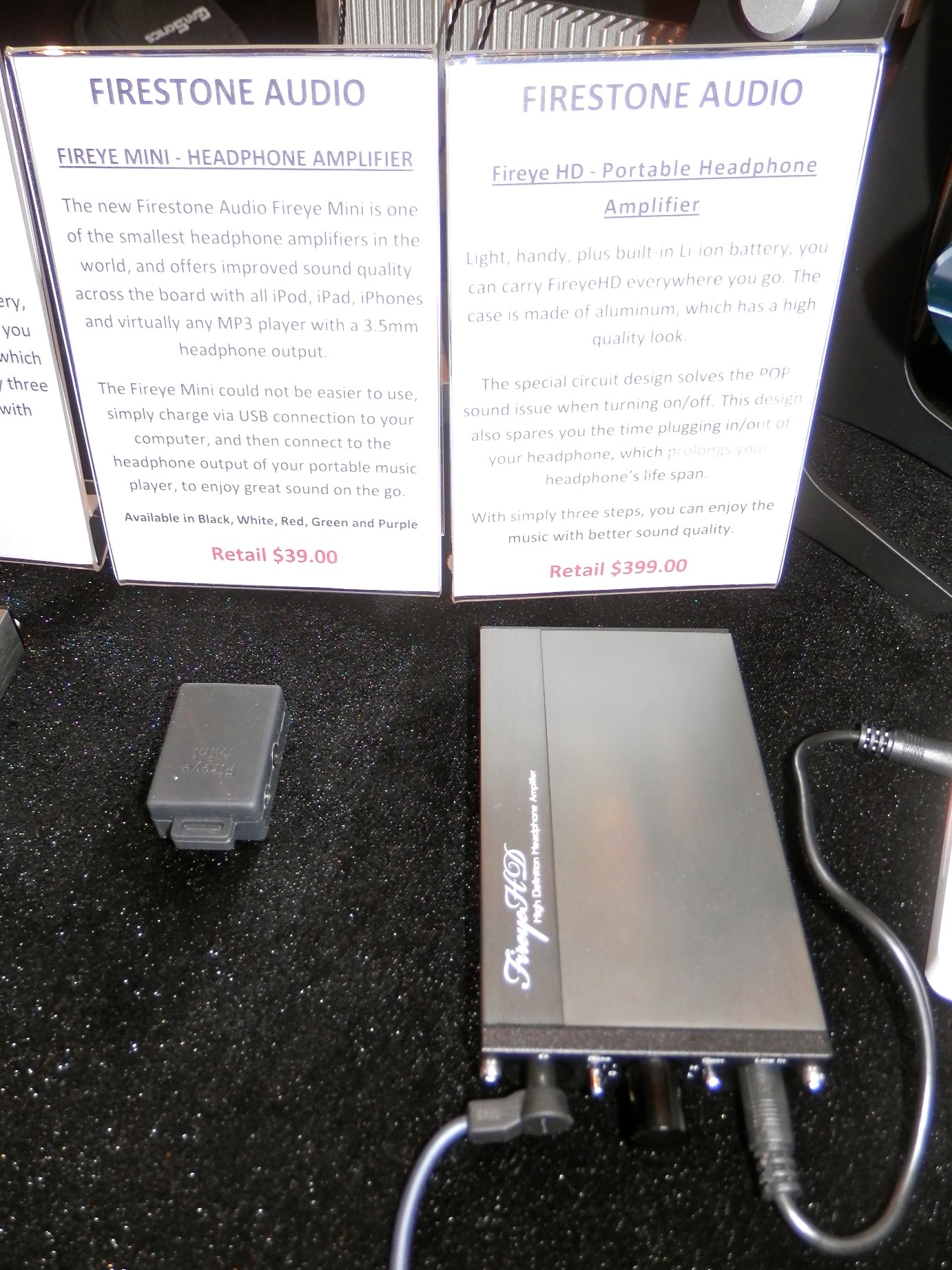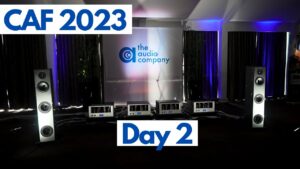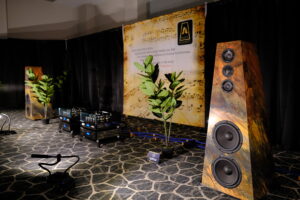
For those of you not able to make it to Denver, CO for the 2012 Rocky Mountain Audio Fest, I’d like to let you in on a little secret. These days, by teaming with HeadFi.org, RMAF now offers attendees a show within a show thanks to an event called Can-Jam. In simple terms, Can-Jam is an exposition and celebration of all things pertaining to high-end headphones, earphones, and the specialized electronics required to drive them.
Below, I describe some of the coolest new products seen and heard at RMAF/Can-Jam 2012. As always, my apologies in advance to any manufacturers whose worthy products I fail to mention.
__________
DigiZoid

Digizoid is a relative newcomer to the marketplace, but I suspect some enthusiasts will find the firm’s new Zo2 “Personal Subwoofer” ($119) absolutely fascinating. Designed as an inline device that basically goes between the source component and your headphone amp, the Zo2 allows users to dial in any of 32 precisely defined low frequency enhancement EQ curves, while also applying settings said to improve the spatial imaging characteristics of headphones.

You might at first glance be tempted to dismiss the Zo2 as a gimmick, and when turned up to its maximum settings it probably is a gimmick, but when used judiciously the Zo2’s effect are subtle, tasteful, and beneficial. During a brief listening test, I found there was also merit to the idea of turning off low frequency enhancement altogether and using only the Zo2’s spatial enhancement circuits. The latter don’t necessarily make headphones image the way speakers do, but they do represent a step in the right direction.
Ear Sonics
The French firm Ear Sonics made an appearance at Can Jam under the auspices of its new U.S. distributor HDL, and was showing its SM1 ($299) earphone, which sports “1 dual HQ balanced armature driver,” dual-driver SM2v2 ($399), and triple-driver SM3v2 earphones ($499). All three are universal-fit models that aim, says Ear Sonics, “to attain audio quality never reached before with universals.”

Reader in the UK and Europe will also want to note that, in addition to the universal fit earphones mentioned above, Ear Sonics also offers a range of five custom-fit in-ear monitors, two portable amplifiers, and various earphone related accessories. It is not clear at this stage whether HDL will import these models to the U.S., but Euro-enthusiasts should be able to find them quite easily.
Exit Level Audio

Exit Level Audio describes itself as a company for those who have moved past entry-level equipment and mid-fi gear and are now ready to settle down with components of enduring excellence. With this philosophy in mind, Exit Level offers its custom made (or as British readers might term it, “bespoke”) tube-powered Annapurna headphone amplifier, with transformer-coupled inputs and outputs ($6000). Exit Level offers customers a range of possible customization options and maintain close ties with customers during the build process, sending owners photo updates as their amplifiers move toward completion.
Final Audio Design

Final Audio Design is a distinguished Japanese high-end audio company that has built battery-powered full-size audio components for home use (as previously reviewed in Hi-Fi+), but that now focuses heavily on very high-end earphones. Several of the firm’s designs are a bit unorthodox, including a range of Piano Forte in-ear models whose housings are made of various blends of polished metals, but that deliberately do not provide rubber ear tips. Final Audio representatives suggested, though, that I try the firm’s somewhat more conventional-looking Heaven VI earphones ($625), which provide gorgeous polished chrome copper housings and feature single, purist-oriented, full-range balanced armature drivers. Based on a very brief listen, I think the Final’s show great potential—especially in terms of timbral purity and exquisite low-level detail.

Firestone Audio


Firestone Audio is a Taiwanese audio company that specializes in electronics for headphone, earphone, and personal audio enthusiasts. The firm’s Can-Jam display highlighted the five following models that will be distributed in the US by HDL:
– Fireye Mini headphone amp ($39): a miniature (roughly USB dongle-sized) headphone amp that sports a rugged rubber outer covering and whose batteries can be charged from a USB port.
– Fireye HA Headphone Amp ($149): a larger format (roughly iPod-sized) portable headphone amp with Lithium ion battery pack.
– Fireye DA DAC/Headphone Amp ($199): a roughly iPod-sized portable, USB-powered headphone amp/DAC with support for up to 24/96 resolution digital audio files.
– Fireye HD Headphone Amp ($399): a roughly iPod-sized portable, “High Definition” (hence, “HD”) headphone amp.
– Bobby Headphone Amp ($999): Arguably Firestone’s most ambitious design, the Bobby is a desktop headphone amplifier with balanced (XLR-type) inputs and outputs.


Fosgate Signature

In recent years Fosgate has been best known in the high-end audio world for its impressive $2500 Fosgate Signature Tube-Powered Phonostage, but now Fosgate has directed the same sort of design insights that went in to the phonostage to create the Fosgate Signature Tube-Powered Headphone Amplifier ($1500). Aesthetically, the headphone amp takes design cues directly from the phonostage (which many regard as a lovely piece of audio sculpture), but you can also see Fosgate’s distinctive influence in the somewhat unusual user control offering the headphone amp provide.

As many enthusiasts know, Mr. Fosgate was one of the prime movers’n’shakers behind creation of the famous Dolby ProLogic surround sound circuit (as found in almost all modern home theater systems). He has evidently applied some of that same know-how in this headphone amp, which sports control settings for two levels of headphone-oriented surround sound processing (though for purists the surround circuit can of course be disengaged completely. Likewise, Fosgate has set up his amp with neutral voicing, but has provided two switch-selectable levels of low-frequency boost for those ‘phones that may need a bit of lift in the bottom octave(s).
Fostex
Many people think of the Japanese firm Fostex primarily as a giant in the pro-sound world, but the fact is that the firm has had and will continue to have a very strong presence in the high-end headphone/personal audio universe as evidenced by three products highlighted at RMAF.

First up are the firm’s flagship TH-900 full-size headphones ($1999) whose exotic dynamic drivers feature motor assemblies that offer a staggering 1.5 Tesla (yep, you read that right) of magnetic flux density. To put this remark in context, bear in mind that the previous flux density record holder was Beyerdynamics’ world-class T1 Tesla headphone, which upon its inception offered a then groundbreaking 1 Tesla driver. At least one friend of Hi-Fi+ and Playback (though not a member of either magazine’s staff) has volunteered the opinion that the TH-900 may be the most linear and best-sounding dynamic driver-type headphone now on the market.
Next up we got a preview of a model destined to become a (somewhat) cost-reduced version of the TH-900; namely, the TH-600 (~$1499), which sports 1 Tesla dynamic drivers.

Finally, Fostex’ HP-A8C DAC/headphone amp ($1999) is now in full production release (it was shown at last year’s Can-Jam as a pilot production prototype. The HP-A8C is a desktop component that, upon close inspection, seems almost unbelievably full-featured. For starters, the HP-A8C sports a stereo analog input plus a 32/192-capable Asahi Kasei AK4399 DAC, which supports the unit’s digital inputs: two optical, one coax, one AES/EBU, and one USB. Moreover, the HP-A8C provides an SD card slot through which it is possible to play DSD-format audio files (which can also be played through the USB input). There are also two Asahi Kasei-designed digital filter options, including a “minimum delay” setting said to “eliminate pre-echo.” The faceplate sports output jacks for two headphones, an alphanumeric status display, and controls for selecting inputs and outputs, where the user can choose digital (coax or optical) or analog (stereo RCA jack) outputs, and has the option of choosing “Direct Out” settings that bypass the HP-A8C’s volume control. Last but not least, the HP-A8C comes with a compact, full-function remote.

HeadAmp
Depending on whom you ask, HeadAmp may be best known in some high-end headphone circles for its spectacular, Gilmore-designed, tube-powered Blue Hawaii SE electrostatic headphone amp, but for Can Jam the firm focused on two new product positioned at much more modest price points. Specifically, HeadAmp showed its new, ultra-compact, USB-powered, 16/48-capable Pico USB Upsampling DAC ($299) and its impressive Pico Power 18V portable headphone amp ($450). For both these units the emphasis is less on “Oooh-Ahhh”-grade specifications designed to wow the masses and more on the fundamentals of build quality and sound quality.

In fact, company founder Justin Wilson told Hi-Fi+ he considers the Pico Power 18V the best sounding portable amp the company has offered to date. As to build quality, let’s just say that Wilson appreciates finer points of workmanship that most manufacturers either don’t know about or (perhaps) don’t care about. His dedicated efforts add up to quality you can readily see and feel whenever you lay hands on HeadAmp products.
HiFiMAN

HiFiMAN is arguably best known for its broad family of great-sounding planar magnetic headphones, but long before the firm ever made headphones it got its start by offering high performance portable music players (in fact, in the early days the company offered what were essentially rebuilt and seriously hot-rodded Sony Walkmans—hence the name “HiFiMAN”). You can see those roots in a highly evolved form in an upcoming new HiFiMAN product that was previewed at Can Jam: namely, the HM-901 high resolution portable music player/DAC (~$1000), which HiFiMAN claims will be “the best sounding portable music player on the market.”

To get an idea of just how serious a product the HM-901 is meant to be, understand that it will be a portable player based on not one but two ESS 32-bit ES9018 Sabre DAC chips, which are used to provide decoding for multiple digital audio formats at resolutions up to 24/192. But resolution, alone, is only part of the story, because the HM-901 is exceptionally full-featured and capable of being used not just as a portable player, but in many other contexts. For example, the HM-901 provides a lovely full-color graphical user interface, a built-in WiFi (music server) interface, a socket for installation various types of optional amplifier modules, a stepped attenuator volume control (whose design is the subject of a patent application), and an I/O socket that provides access (via an optional break-out cable) to the following: analog line out connections, coax inputs and outputs, a USB port, and a charging port. Several options are planned for the HM-901, including an outboard power supply, optional amplifier cards and a tabletop dock that will enable to HM-901 to serve as the primary DAC in full-size home audio systems. Pricing for the HM-901 and optional accessories is still subject to change, as there are numerous small configuration details yet to be worked out. To demonstrate the HM-901’s prowess, HiFiMAN invited listeners to compare the sound of their new portable to a very costly Meridian disc player/DAC, both playing identical music files, with results that were eye opening to say the least.

Also new from HiFiMAN was a very ambitious new earphone called the RE-600 Songbird ($399), which is a high-end dynamic driver-based model where the driver features motor assemblies based on extremely power rare earth magnets and diaphragms made of an exotic, dual-layer, Titanium-based materials. The RE-600 also uses conductor cables made of high purity silver/copper. If it seems odd for HiFiMAN to base its top-tier earphone on a single dynamic driver (where many manufacturers are instead using multiple balanced armature drivers), note that no less an earphone authority than Sennheiser has just made a similar choice with its new flagship IE 900 earphone.
Jaben (representing GoVibe and Hippo)

Jaben is a fascinating, international distributor/retailer of a very wide range of headphones, earphones, and headphone-related electronics. A cursory look at Jaben’s brand list is most impressive, because the firms sells products from Alessandro, Audio-Technica, Beyerdynamic, CEntrance, Corda, Crossroads, EarSonics, Feels Electronics, Final Audio Design, FutureSonics, Goldring, GoVibe, Grado, Graham Slee, Hippo, Hippocase, Klipsch, Koss, Ordnance, Phonak Audeo, Radius, Sennheiser, and Sony. For Can-Jam, though, the firm focused on showing small portable electronics products from two of its suppliers: GoVibe and Hippo.

I don’t have space to cover in detail all of the models shown at Can Jam but a small smattering would include the GoVibe PortaTube+ tube-powered headphone amp with 24/96 DAC (we didn’t catch the price, but the amp-only PortaVibe sells for $658), the GoVibe Vest+ portable solid state amp with built-in 24/192 DAC ($438), the Hippo Biscuit MP3 player, and the Hippo Cricri+ portable headphone amp with 24/96 USB DAC ($168).
JH Audio
JH Audio is one of the world’s premier makers of custom-fit in-ear monitors, but for Can-Jam the firm’s biggest news was not so much a new product but a new technology that dramatically improves the firm’s two top-tier monitors: the JH 13 PRO ($1099) and JH 16 PRO ($1149). The technology to which I refer is JH’s new freqphase time/phase alignment waveguide (patents pending), and here’s why it is significant.

Like many custom-fit IEM makers, JH Audio is a proponent of using multiple balanced armature drivers in its monitors: six per earpiece in the JH 13 PRO and eight per earpiece in the JH 16 PRO. Through careful design it is a relatively straightforward matter to give these monitors smooth, even frequency (or amplitude) response. However, achieving optimal time/phase coherency has—until now—proven a much more difficult problem to solve, with earpieces typically exhibiting substantial phase shifts over the audio spectrum.

With its new Jerry Harvey-developed freqphase waveguide, however, JH Audio is now able to give its top models exceptionally smooth, even phase coherent response from 20Hz on up to 20kHZ. Can you really hear the difference? Judging by what I heard from a demo set of new-generation JH 16 PRO’s at Can-Jam as compared to the sound of my personal, earlier-generation pair of JH 16 PRO’s I would say the difference is audible, large in magnitude, and entirely beneficial. Expect a full review of the next-gen JH 16 PRO within the next few months.
By Chris Martens
More articles from this editorRead Next From Show
See all
Best of Show: Southwest Audio Fest 2024
- Mar 18, 2024

Capital Audio Fest 2023 | Day 2 Show Report
- Nov 17, 2023




















